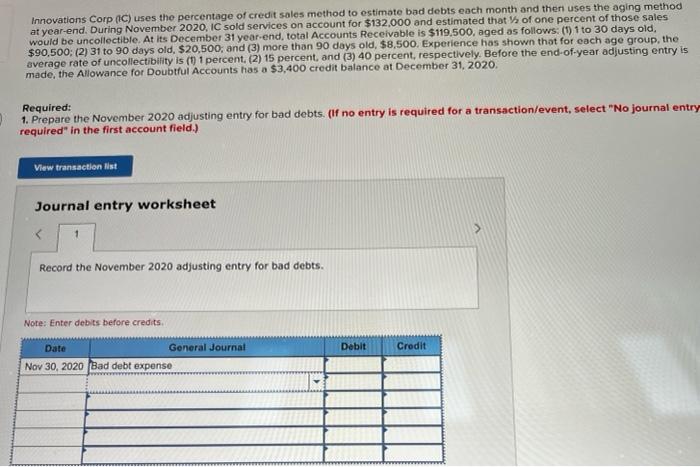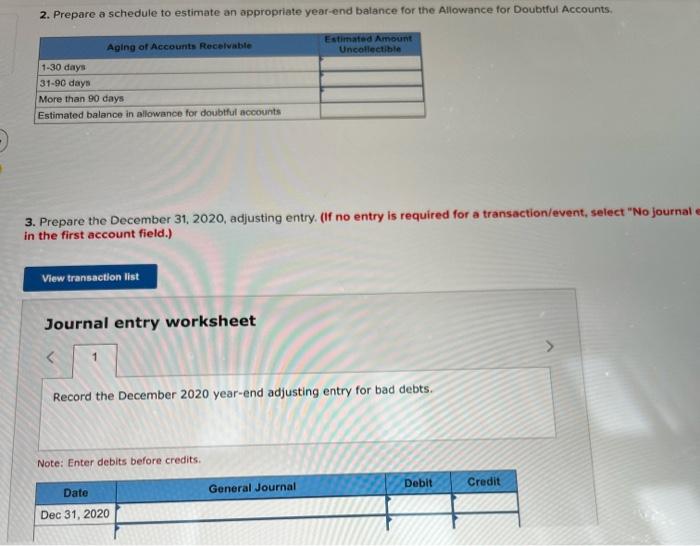Answered step by step
Verified Expert Solution
Question
1 Approved Answer
Innovations Corp (C) uses the percentage of credit sales method to estimate bad debts each month and then uses the aging method at year-end. During



 Innovations Corp (C) uses the percentage of credit sales method to estimate bad debts each month and then uses the aging method at year-end. During November 2020, IC sold services on account for $132.000 and estimated that of one percent of those sales would be uncollectible. At its December 31 year-end, total Accounts Receivable is $119.500, aged as follows: (1) 1 to 30 days old, $90,500: (2) 31 to 90 days old, $20,500, and (3) more than 90 days old, $8.500. Experience has shown that for each age group, the average rate of uncollectibility is (t) 1 percent. (2) 15 percent, and (3) 40 percent, respectively. Before the end-of-year adjusting entry is made, the Allowance for Doubtful Accounts has a $3,400 credit balance at December 31, 2020. Required: 1. Prepare the November 2020 adjusting entry for bad debts. (If no entry is required for a transaction/event, select "No journal entry required" in the first account field.) View transaction ist Journal entry worksheet Record the November 2020 adjusting entry for bad debts. Note: Enter debits before credits Debit Credit Date General Journal Nov 30, 2020 Bad debt expense 2. Prepare a schedule to estimate an appropriate year-end balance for the Allowance for Doubtful Accounts Aging of Accounts Receivable Estimated Amount Uncatlectible 1-30 days 31-90 days More than 90 days Estimated balance in allowance for doubtful accounts 3. Prepare the December 31, 2020, adjusting entry. (If no entry is required for a transaction/event, select "No journal in the first account field.) View transaction list Journal entry worksheet Record the December 2020 year-end adjusting entry for bad debts. Note: Enter debits before credits Debit Credit Date General Journal Dec 31, 2020 3. Prepare the December 31, 2020, adjusting entry. (If no entry is required for a transaction/event, select "No in the first account field.) View transaction list Journal entry worksheet Record the December 2020 year-end adjusting entry for bad debts. Note: Enter debits before credits. General Journal Debit Credit Date Dec 31, 2020 Record entry Clear entry View general journal 4. Show how the various accounts related to accounts receivable should be shown on the December 31, 2020, balance sheet (Amounts to be deducted should be indicated with minus sign.) Partial Balance sheet at December 31, 2020 Accounts receivable, not of allowance
Innovations Corp (C) uses the percentage of credit sales method to estimate bad debts each month and then uses the aging method at year-end. During November 2020, IC sold services on account for $132.000 and estimated that of one percent of those sales would be uncollectible. At its December 31 year-end, total Accounts Receivable is $119.500, aged as follows: (1) 1 to 30 days old, $90,500: (2) 31 to 90 days old, $20,500, and (3) more than 90 days old, $8.500. Experience has shown that for each age group, the average rate of uncollectibility is (t) 1 percent. (2) 15 percent, and (3) 40 percent, respectively. Before the end-of-year adjusting entry is made, the Allowance for Doubtful Accounts has a $3,400 credit balance at December 31, 2020. Required: 1. Prepare the November 2020 adjusting entry for bad debts. (If no entry is required for a transaction/event, select "No journal entry required" in the first account field.) View transaction ist Journal entry worksheet Record the November 2020 adjusting entry for bad debts. Note: Enter debits before credits Debit Credit Date General Journal Nov 30, 2020 Bad debt expense 2. Prepare a schedule to estimate an appropriate year-end balance for the Allowance for Doubtful Accounts Aging of Accounts Receivable Estimated Amount Uncatlectible 1-30 days 31-90 days More than 90 days Estimated balance in allowance for doubtful accounts 3. Prepare the December 31, 2020, adjusting entry. (If no entry is required for a transaction/event, select "No journal in the first account field.) View transaction list Journal entry worksheet Record the December 2020 year-end adjusting entry for bad debts. Note: Enter debits before credits Debit Credit Date General Journal Dec 31, 2020 3. Prepare the December 31, 2020, adjusting entry. (If no entry is required for a transaction/event, select "No in the first account field.) View transaction list Journal entry worksheet Record the December 2020 year-end adjusting entry for bad debts. Note: Enter debits before credits. General Journal Debit Credit Date Dec 31, 2020 Record entry Clear entry View general journal 4. Show how the various accounts related to accounts receivable should be shown on the December 31, 2020, balance sheet (Amounts to be deducted should be indicated with minus sign.) Partial Balance sheet at December 31, 2020 Accounts receivable, not of allowance




Step by Step Solution
There are 3 Steps involved in it
Step: 1

Get Instant Access to Expert-Tailored Solutions
See step-by-step solutions with expert insights and AI powered tools for academic success
Step: 2

Step: 3

Ace Your Homework with AI
Get the answers you need in no time with our AI-driven, step-by-step assistance
Get Started


